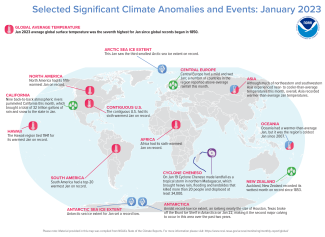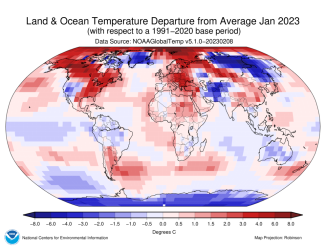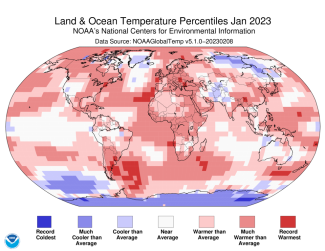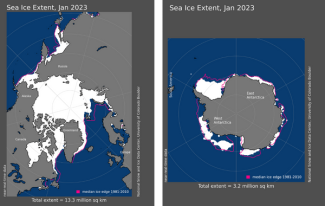Earth had its seventh-warmest January on record; Global sea ice extent hit record low

January Highlights:
- Europe had its warmest January on record, while North America and Africa each had a January that ranked among the 10 warmest on record.
- Arctic sea ice extent ranked third lowest on record, while Antarctic sea ice hit a record low for January.
- Cyclone Cheneso in the South Indian Ocean was the only storm of tropical cyclone strength this month.
Globally, January 2023 was the seventh-warmest January in the 174-year NOAA record. According to NCEI’s Global Annual Temperature Outlook, it is virtually certain (> 99.0%) that the year 2023 will rank among the 10-warmest years on record.
This monthly summary, developed by scientists at NOAA’s National Centers for Environmental Information, is part of the suite of climate services NOAA provides to government, business, academia and the public to support informed decision-making.
Coinciding with the release of the January 2023 Global Climate Report, the NOAA Global Surface Temperature (NOAAGlobalTemp) dataset version 5.1.0 replaced version 5.0.0. This new version includes complete global coverage and an extension of the data record back in time an additional 30 years to January 1850. While anomalies and ranks might differ slightly from what was reported previously, the main conclusions regarding global climate change are very similar to the previous version. Please see our Commonly Asked Questions Document and web story for additional information.
Monthly Global Temperature
The January global surface temperature was 1.57°F (0.87°C) above the 20th-century average of 53.6°F (12.0°C). This ranks as the seventh-warmest January in the 174-year record. January 2023 marked the 47th consecutive January and the 527th consecutive month with temperatures at least nominally above the 20th-century average.
The year started off unusually warm and mild in Europe, which had its warmest January on record. North America had its fifth-warmest January on record, while Africa had its sixth. South America had a January that ranked among its 20 warmest on record. Asia and Oceania each had a warmer-than-average January, but it did not rank among their 20 warmest on record. In fact, Oceania had its coldest January since 2007.
Temperatures were above average throughout most of Europe and the Arctic, much of Africa and northern and eastern North America, and across parts of southern South America and northwestern, central, and southeastern Asia. Sea surface temperatures were above average across much of the northern, western and southwestern Pacific and the Atlantic. The Hawaii region tied January 1941 for its warmest January on record. Overall, record warm temperatures covered 3.6% of the world’s surface this month.
Temperatures were near- to cooler-than-average throughout much of Oceania and Antarctica, as well as across parts of northeastern and southwestern Asia, the western U.S., Greenland and northern and central South America. Sea surface temperatures were below average over much of the south-central, central and eastern tropical Pacific and much of the central and southeastern Indian Ocean.
Sea Ice and Snow Cover
Globally, January 2023 saw the lowest January sea ice extent on record. This surpassed the previous record low, set in 2017, by 150,000 square miles.
Arctic sea ice extent in January averaged 5.15 million square miles, which is about 243,000 square miles below the 1991-2020 average. This marks the third-smallest January extent in the 45-year record. The January 2023 Antarctic sea ice extent hit a record low for January at 1.25 million square miles, which is about 700,000 square miles below the 1991-2020 average. This January’s extent was roughly 210,000 square miles smaller than the previous record low from January 2017.
According to data from NOAA and analysis by the Rutgers Global Snow Lab, the Northern Hemisphere snow cover extent during January was about 376,000 square miles below the 1991-2020 average. This ranks as the 17th-lowest Northern Hemisphere snow cover extent on record. Extent was above average throughout much of western North America and eastern Asia, and below average across most of eastern North America, Europe and southern Asia. Overall, North America had a near-average snow cover extent this month while Eurasia tied 1991 for its ninth-lowest extent in the 57-year record.
Global Precipitation
Above-average January precipitation was observed across parts of northeastern and inland eastern Northern America, the central and southern coast of the western U.S., central Europe, central Asia and eastern Oceania. Auckland, New Zealand recorded its wettest month on record since 1853. In the U.S., nine back-to-back atmospheric rivers pummeled California, which brought a total of 32 trillion gallons of rain and snow to the state this January. Meanwhile, drier-than-average conditions were present throughout much of Mexico and across parts of the northwestern U.S. and eastern, southern and western Asia.
Global Tropical Cyclones
Four named storms occurred across the globe in January. No storms reached major tropical cyclone strength (≥111 mph), but one reached tropical cyclone strength (≥74 mph). These counts are all below 1991-2020 averages for January. No storms were active in the Northern Hemisphere, which is typical for January. Cyclone Cheneso, which formed in the South Indian Ocean, brought heavy rain and flooding to Madagascar and was the only storm of tropical cyclone strength this month. Of the three other storms, two occurred in the Southwest Pacific and one off the coast of Australia.
For a more complete summary of climate conditions and events, see our January 2023 Global Climate Report.








